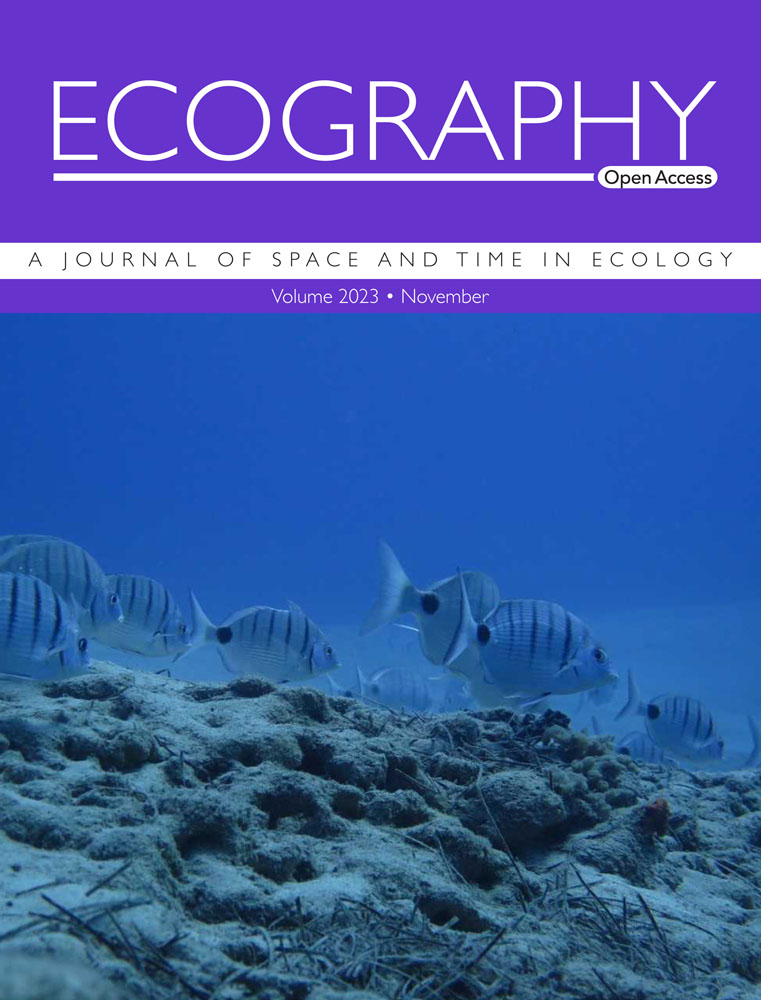The division of food space among mammalian species on biomes
IF 5.4
1区 环境科学与生态学
Q1 BIODIVERSITY CONSERVATION
引用次数: 0
Abstract
Understanding how species' ecological partitioning functions across biomes is fundamental to macroecology and conservation biology. Here, we examine the global distribution of dietary strategies in terrestrial mammals, focusing on how biome specialization modulates trophic diversity and structure at a broad geographical scale. Using species‐level data from over 3600 terrestrial mammal species, we constructed a multivariate dietary space and quantified the area, redundancy, dispersion, uniqueness, and turnover of trophic strategies across ten major biomes. Species were classified as biome specialists, moderate generalists, or extreme generalists based on their biome breadth. By analysing biome specialists and generalists separately, we show that biome specialists tend to exhibit more constrained and compositionally distinct dietary niches in less productive biomes, while generalists, particularly moderate generalists, dominate functional space occupancy in all biomes, even the harsher ones such as tundra and taiga. This highlights how environmental constraints and ecological roles shape trophic strategies at a global scale. Notably, extreme generalists tended to exhibit more carnivorous or insectivorous diets, suggesting a strategy based on mobile predation or opportunism rather than a highly diversified omnivory. Despite these general patterns, highly productive biomes supported the greatest diversity of dietary strategies, with higher functional redundancy and niche packing. Nestedness and turnover analyses revealed that biome specialists diets are often subsets of generalists diets, but with significant compositional shifts across biomes. These findings underscore the dual role of biome generalists as both functional stabilizers and potential limiters of ecological diversity, and highlight the vulnerability of specialist species to global change. Our study offers a mechanistic framework for understanding how dietary strategies interact with environmental filtering, and for identifying functional risks in changing ecosystems.哺乳动物物种在生物群系上的食物空间划分
了解物种在生物群系间的生态分配是宏观生态学和保护生物学的基础。在这里,我们研究了陆生哺乳动物饮食策略的全球分布,重点关注生物群系专业化如何在广泛的地理尺度上调节营养多样性和结构。利用3600多种陆生哺乳动物的物种水平数据,构建了一个多元饮食空间,并量化了10个主要生物群系中营养策略的面积、冗余、分散、独特性和周转。根据物种的生物群系宽度,将物种分为生物群系专门型、中等多面手型和极端多面手型。通过分别分析生物群系专家和多面手,我们发现,生物群系专家往往在生产力较低的生物群系中表现出更多的限制和组成不同的饮食生态位,而多面手,特别是适度的多面手,在所有生物群系中都占据着主要的功能空间,即使是苔原和针叶林等环境较恶劣的生物群系。这突出了环境约束和生态角色如何在全球范围内塑造营养策略。值得注意的是,极端通才倾向于表现出更多的肉食性或虫食性饮食,这表明一种基于移动捕食或机会主义的策略,而不是高度多样化的杂食。尽管存在这些普遍的模式,但高产的生物群落支持最大的饮食策略多样性,具有更高的功能冗余和生态位包装。巢性和周转分析表明,生物群系专家饮食通常是通才饮食的子集,但在生物群系之间存在显著的组成变化。这些发现强调了生物群系通才作为生态多样性的功能稳定器和潜在限制者的双重作用,并强调了特殊物种对全球变化的脆弱性。我们的研究为理解饮食策略如何与环境过滤相互作用以及识别不断变化的生态系统中的功能风险提供了一个机制框架。
本文章由计算机程序翻译,如有差异,请以英文原文为准。
求助全文
约1分钟内获得全文
求助全文
来源期刊

Ecography
环境科学-生态学
CiteScore
11.60
自引率
3.40%
发文量
122
审稿时长
8-16 weeks
期刊介绍:
ECOGRAPHY publishes exciting, novel, and important articles that significantly advance understanding of ecological or biodiversity patterns in space or time. Papers focusing on conservation or restoration are welcomed, provided they are anchored in ecological theory and convey a general message that goes beyond a single case study. We encourage papers that seek advancing the field through the development and testing of theory or methodology, or by proposing new tools for analysis or interpretation of ecological phenomena. Manuscripts are expected to address general principles in ecology, though they may do so using a specific model system if they adequately frame the problem relative to a generalized ecological question or problem.
Purely descriptive papers are considered only if breaking new ground and/or describing patterns seldom explored. Studies focused on a single species or single location are generally discouraged unless they make a significant contribution to advancing general theory or understanding of biodiversity patterns and processes. Manuscripts merely confirming or marginally extending results of previous work are unlikely to be considered in Ecography.
Papers are judged by virtue of their originality, appeal to general interest, and their contribution to new developments in studies of spatial and temporal ecological patterns. There are no biases with regard to taxon, biome, or biogeographical area.
 求助内容:
求助内容: 应助结果提醒方式:
应助结果提醒方式:


